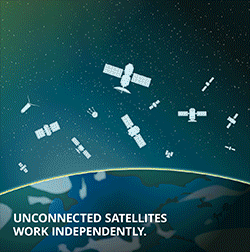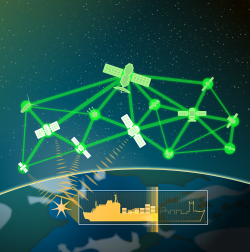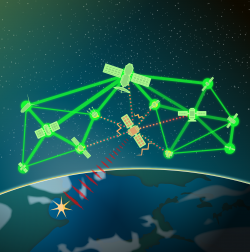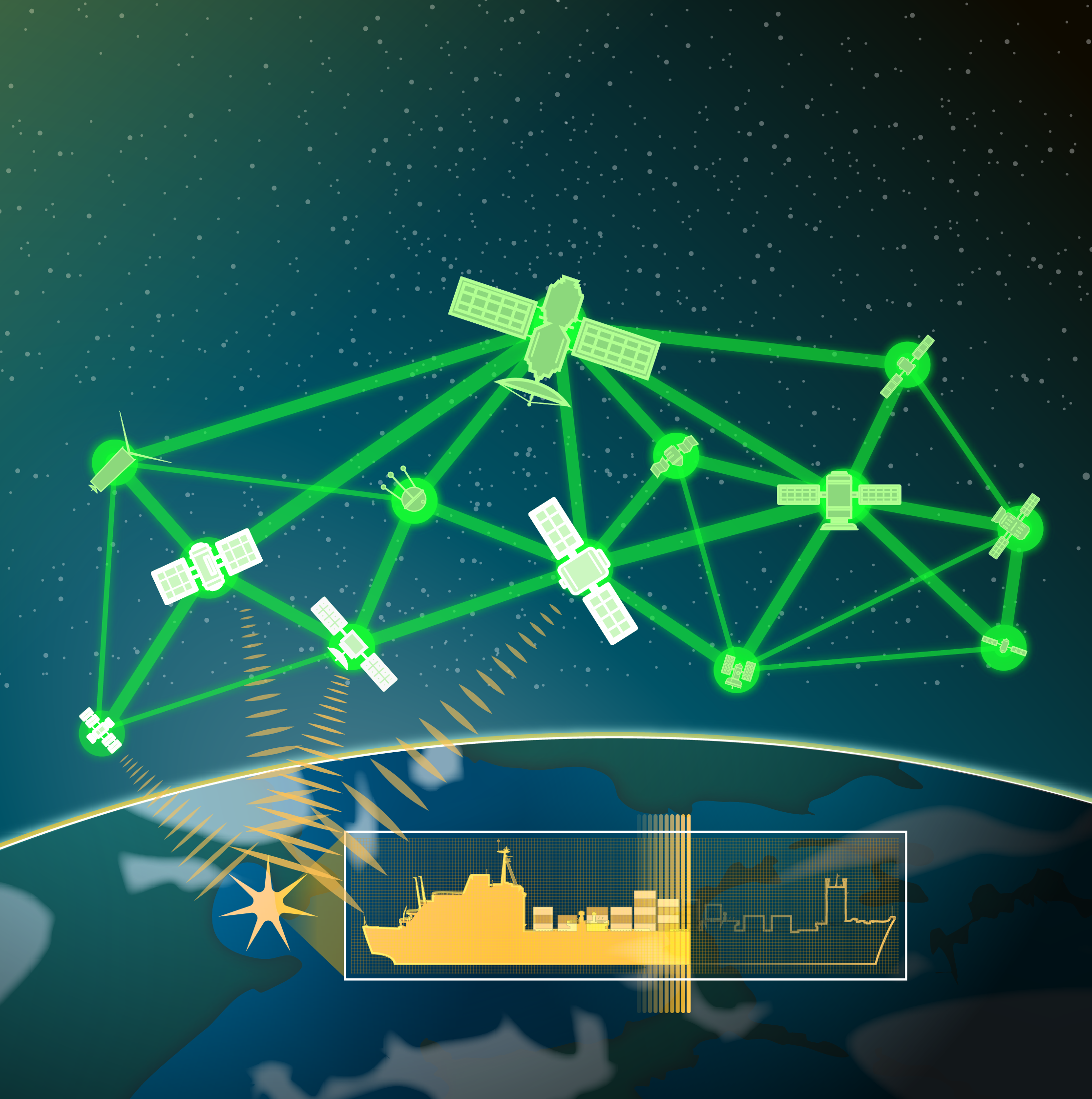
An animation starting with unconnected satellites shows how an autonomous constellation developed by Sandia National Laboratories, the Air Force Research Laboratory and others could work together during national security missions. (Image by Eric Lundin) Click on the thumbnail for a higher resolution GIF.
ALBUQUERQUE, N.M. — Imagine a satellite observing ships on the ocean. As it takes pictures of each ship, an algorithm decides what kind of vessel it is. But one sneaky sailor paints a pattern on the deck that confuses the satellite, so it can’t decide what it’s looking at.
How can the satellite work around its problem? According to new research, the answer could someday be: with a little help from its friends.
For the past six years, Sandia National Laboratories has been working on an autonomy project led by the Air Force Research Laboratory to enable a cluster of relatively small and inexpensive satellites to work together as a single, autonomous unit. The project could improve the nation’s ability to conduct national security missions, including intelligence, surveillance, reconnaissance, climate monitoring and emergency response.
A confused satellite, for example, could communicate its problem to others in the network, which could straight away point their sensors to the same spot, combine their data and make a positive identification.
“This is a paradigm shift from large, exquisite, billion-dollar satellites to talking about multiple million-dollar satellites,” said Sandia project manager Jered Mitchell.
While current research aims to connect up to about a dozen satellites, researchers say that further development could lead to connecting much larger networks.
“The ultimate idea is to scale up to constellations that might cover virtually the entire globe — and to potentially coordinate data collection even with non-space assets,” like sensors on the ground or on planes, said Sandia’s Drew Woodbury, a senior manager in Sandia’s space programs.
Teaming satellites to save taxpayer dollars

When one satellite detects a possible object of interest, others in the group could help identify it with more information from their sensors. (Image by Eric Lundin) Click on the thumbnail for a higher resolution image.
Working together, an autonomous group of satellites could reduce the risk of relying on any one satellite and diminish downtime while engineers on the ground try to resolve technical difficulties. If one machine in the network stops working, others could automatically redirect their sensors to fill the gap or reroute communications around it.
“Overall, the intent is to build in resiliency so that the mission continues,” Woodbury said.
Sandia has been heavily involved in the project, developing machine learning and autonomy algorithms, radar sensors, computer models, communications protocols and flight software. Researchers have been building specialized hardware for space, where budgets for size, weight and power are commonly tighter than on the ground. They have adapted distributed software to operate on multiple satellites without conventional, land-based communications.
“We want applications to seamlessly communicate without worrying about where other applications are located or how messages are physically routed between them,” said Ryan Hess, a Sandia manager in communications technologies.
Many uses for autonomous, multisensor response

Satellites react to a malfunctioning member of the group in this artist’s rendering of what an autonomous constellation could look like. Sandia National Laboratories is supporting the Air Force Research Laboratory project. (Image by Eric Lundin) Click on the thumbnail for a high-resolution image.
The beauty of satellite autonomy, Woodbury said, is that it could be useful for many applications. These could potentially include automatically turning a group of telescopes to study a fleeting burst of gamma radiation emanating from somewhere deep in the cosmos.
“The fundamental smarts of the system are just designed to look for information, however that information is defined,” Woodbury said. “These capabilities can be used to figure out in real time where a system should look and not just look where a human told it to look.”
While these new applications have not been tried in space, team members are testing them on electronics and communications systems that have.
“We are doing this to prove these applications can fit in the resource-constrained environments of a spacecraft,” Hess said.
Nicolas Bikhazi, a Sandia manager over radar research, said, “The system model can be used to perform lab experiments and trade studies with various sensor constellation configurations to see which sensor constellations work best.”
This way, researchers are exploring future architectures and designing their satellite dream team.
Sandia National Laboratories is a multimission laboratory operated by National Technology and Engineering Solutions of Sandia LLC, a wholly owned subsidiary of Honeywell International Inc., for the U.S. Department of Energy’s National Nuclear Security Administration. Sandia Labs has major research and development responsibilities in nuclear deterrence, global security, defense, energy technologies and economic competitiveness, with main facilities in Albuquerque, New Mexico, and Livermore, California.
Sandia news media contact: Troy Rummler, trummle@sandia.gov, 505-249-3632
